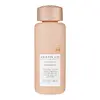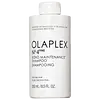What's inside
What's inside
 Key Ingredients
Key Ingredients

 Benefits
Benefits

 Concerns
Concerns

 Ingredients Side-by-side
Ingredients Side-by-side

Water
Skin ConditioningSodium Cocoyl Isethionate
CleansingCocamidopropyl Betaine
CleansingSodium Methyl Cocoyl Taurate
CleansingSodium Chloride
MaskingParfum
MaskingGlycerin
HumectantCetearamidoethyldiethonium Succinoyl Hydrolyzed Pea Protein
CleansingHypnea Musciformis Extract
Skin ProtectingSargassum Filipendula Extract
Skin ProtectingChamomilla Recutita Flower Extract
MaskingHelianthus Annuus Seed Oil
EmollientMangifera Indica Seed Butter
Skin ConditioningPersea Gratissima Oil
Skin ConditioningRicinus Communis Seed Oil
MaskingCoco-Glucoside
CleansingGelidiella Acerosa Extract
Skin ProtectingAlgin
MaskingCarrageenan
Chitosan
Cocamide Mipa
EmulsifyingPEG-200 Hydrogenated Glyceryl Palmate
CleansingPhenoxyethanol
PreservativeGlycol Stearate
EmollientPropanediol
SolventCoconut Acid
CleansingSodium Isethionate
CleansingPEG-7 Glyceryl Cocoate
EmulsifyingGlyceryl Stearate
EmollientPEG-100 Stearate
Guar Hydroxypropyltrimonium Chloride
Skin ConditioningCaprylyl Glycol
EmollientCitric Acid
BufferingEthylhexylglycerin
Skin ConditioningIsopropanolamine
BufferingMethyl Cocoate
EmollientTocopherol
AntioxidantSorbitol
HumectantCaprylic/Capric Triglyceride
MaskingSorbitan Oleate
EmulsifyingXanthan Gum
EmulsifyingCoumarin
PerfumingLinalool
PerfumingWater, Sodium Cocoyl Isethionate, Cocamidopropyl Betaine, Sodium Methyl Cocoyl Taurate, Sodium Chloride, Parfum, Glycerin, Cetearamidoethyldiethonium Succinoyl Hydrolyzed Pea Protein, Hypnea Musciformis Extract, Sargassum Filipendula Extract, Chamomilla Recutita Flower Extract, Helianthus Annuus Seed Oil, Mangifera Indica Seed Butter, Persea Gratissima Oil, Ricinus Communis Seed Oil, Coco-Glucoside, Gelidiella Acerosa Extract, Algin, Carrageenan, Chitosan, Cocamide Mipa, PEG-200 Hydrogenated Glyceryl Palmate, Phenoxyethanol, Glycol Stearate, Propanediol, Coconut Acid, Sodium Isethionate, PEG-7 Glyceryl Cocoate, Glyceryl Stearate, PEG-100 Stearate, Guar Hydroxypropyltrimonium Chloride, Caprylyl Glycol, Citric Acid, Ethylhexylglycerin, Isopropanolamine, Methyl Cocoate, Tocopherol, Sorbitol, Caprylic/Capric Triglyceride, Sorbitan Oleate, Xanthan Gum, Coumarin, Linalool
Water
Skin ConditioningSodium Cocoyl Alaninate
Sodium Cocoyl Isethionate
CleansingCoco-Glucoside
CleansingLauryl Glucoside
CleansingPropanediol
SolventCocamidopropyl Hydroxysultaine
CleansingGlycerin
HumectantAcrylates Copolymer
Polyquaternium-80
CleansingBis-Aminopropyl Diglycol Dimaleate
Skin ConditioningPhenoxyethanol
PreservativeSodium Chloride
MaskingParfum
MaskingCoconut Acid
CleansingCocamide Mipa
EmulsifyingGuar Hydroxypropyltrimonium Chloride
Skin ConditioningPolyglyceryl-4 Caprate
EmulsifyingPolyglyceryl-6 Caprylate
EmulsifyingPolyimide-1
Chlorphenesin
AntimicrobialPanthenol
Skin ConditioningXanthan Gum
EmulsifyingPolyquaternium-7
Cetrimonium Chloride
AntimicrobialEthylhexylglycerin
Skin ConditioningOryza Sativa Bran Extract
Skin ConditioningHydrolyzed Quinoa
Skin ConditioningTrisodium Ethylenediamine Disuccinate
Sarcosine
Skin ConditioningPisum Sativum Seed Extract
Skin ConditioningHelianthus Annuus Extract
EmollientPropylene Glycol
HumectantSclerotium Gum
Emulsion Stabilising1,2-Hexanediol
Skin ConditioningRosmarinus Officinalis Leaf Extract
AntimicrobialTocopherol
AntioxidantSodium Hydroxide
BufferingAlgin
MaskingSodium Hyaluronate
HumectantSodium Benzoate
MaskingBenzyl Alcohol
PerfumingTetrasodium Glutamate Diacetate
Potassium Sorbate
PreservativeCaesalpinia Spinosa Fruit Extract
Skin ProtectingHelianthus Annuus Sprout Extract
Skin ConditioningCitric Acid
BufferingHexyl Cinnamal
PerfumingLimonene
PerfumingCitral
PerfumingCI 19140
Cosmetic ColorantCI 15985
Cosmetic ColorantWater, Sodium Cocoyl Alaninate, Sodium Cocoyl Isethionate, Coco-Glucoside, Lauryl Glucoside, Propanediol, Cocamidopropyl Hydroxysultaine, Glycerin, Acrylates Copolymer, Polyquaternium-80, Bis-Aminopropyl Diglycol Dimaleate, Phenoxyethanol, Sodium Chloride, Parfum, Coconut Acid, Cocamide Mipa, Guar Hydroxypropyltrimonium Chloride, Polyglyceryl-4 Caprate, Polyglyceryl-6 Caprylate, Polyimide-1, Chlorphenesin, Panthenol, Xanthan Gum, Polyquaternium-7, Cetrimonium Chloride, Ethylhexylglycerin, Oryza Sativa Bran Extract, Hydrolyzed Quinoa, Trisodium Ethylenediamine Disuccinate, Sarcosine, Pisum Sativum Seed Extract, Helianthus Annuus Extract, Propylene Glycol, Sclerotium Gum, 1,2-Hexanediol, Rosmarinus Officinalis Leaf Extract, Tocopherol, Sodium Hydroxide, Algin, Sodium Hyaluronate, Sodium Benzoate, Benzyl Alcohol, Tetrasodium Glutamate Diacetate, Potassium Sorbate, Caesalpinia Spinosa Fruit Extract, Helianthus Annuus Sprout Extract, Citric Acid, Hexyl Cinnamal, Limonene, Citral, CI 19140, CI 15985
Ingredients Explained
These ingredients are found in both products.
Ingredients higher up in an ingredient list are typically present in a larger amount.
Algin is brown algae. Algae is an informal term for a group of aquatic organisms that can photosynthesize. It is estimated there are at least 30,000 types of Algae.
Algae contains antioxidants. Antioxidants help fight free-radicals. Free-radicals are molecules that may damage your skin cells, such as pollution.
Citric Acid is an alpha hydroxy acid (AHA) naturally found in citrus fruits like oranges, lemons, and limes.
Like other AHAs, citric acid can exfoliate skin by breaking down the bonds that hold dead skin cells together. This helps reveal smoother and brighter skin underneath.
However, this exfoliating effect only happens at high concentrations (20%) which can be hard to find in cosmetic products.
Due to this, citric acid is usually included in small amounts as a pH adjuster. This helps keep products slightly more acidic and compatible with skin's natural pH.
In skincare formulas, citric acid can:
While it can provide some skin benefits, research shows lactic acid and glycolic acid are generally more effective and less irritating exfoliants.
Most citric acid used in skincare today is made by fermenting sugars (usually from molasses). This synthetic version is identical to the natural citrus form but easier to stabilize and use in formulations.
Read more about some other popular AHA's here:
Learn more about Citric AcidWe don't have a description for Cocamide Mipa yet.
Coco-Glucoside is a surfactant, or a cleansing ingredient. It is made from glucose and coconut oil.
Surfactants help gather dirt, oil, and other pollutants from your skin to be rinsed away.
This ingredient is considered gentle and non-comedogenic. However, it may still be irritating for some.
Learn more about Coco-GlucosideCoconut Acid isn't fungal acne safe.
Ethylhexylglycerin (we can't pronounce this either) is commonly used as a preservative and skin softener. It is derived from glyceryl.
You might see Ethylhexylglycerin often paired with other preservatives such as phenoxyethanol. Ethylhexylglycerin has been found to increase the effectiveness of these other preservatives.
Glycerin is already naturally found in your skin. It helps moisturize and protect your skin.
A study from 2016 found glycerin to be more effective as a humectant than AHAs and hyaluronic acid.
As a humectant, it helps the skin stay hydrated by pulling moisture to your skin. The low molecular weight of glycerin allows it to pull moisture into the deeper layers of your skin.
Hydrated skin improves your skin barrier; Your skin barrier helps protect against irritants and bacteria.
Glycerin has also been found to have antimicrobial and antiviral properties. Due to these properties, glycerin is often used in wound and burn treatments.
In cosmetics, glycerin is usually derived from plants such as soybean or palm. However, it can also be sourced from animals, such as tallow or animal fat.
This ingredient is organic, colorless, odorless, and non-toxic.
Glycerin is the name for this ingredient in American English. British English uses Glycerol/Glycerine.
Learn more about GlycerinThis ingredient is derived from guar gum.
It is a conditioning ingredient, meaning it helps soften skin and hair.
Parfum is a catch-all term for an ingredient or more that is used to give a scent to products.
Also called "fragrance", this ingredient can be a blend of hundreds of chemicals or plant oils. This means every product with "fragrance" or "parfum" in the ingredients list is a different mixture.
For instance, Habanolide is a proprietary trade name for a specific aroma chemical. When used as a fragrance ingredient in cosmetics, most aroma chemicals fall under the broad labeling category of “FRAGRANCE” or “PARFUM” according to EU and US regulations.
The term 'parfum' or 'fragrance' is not regulated in many countries. In many cases, it is up to the brand to define this term.
For instance, many brands choose to label themselves as "fragrance-free" because they are not using synthetic fragrances. However, their products may still contain ingredients such as essential oils that are considered a fragrance by INCI standards.
One example is Calendula flower extract. Calendula is an essential oil that still imparts a scent or 'fragrance'.
Depending on the blend, the ingredients in the mixture can cause allergies and sensitivities on the skin. Some ingredients that are known EU allergens include linalool and citronellol.
Parfum can also be used to mask or cover an unpleasant scent.
The bottom line is: not all fragrances/parfum/ingredients are created equally. If you are worried about fragrances, we recommend taking a closer look at an ingredient. And of course, we always recommend speaking with a professional.
Learn more about ParfumPhenoxyethanol is a preservative that has germicide, antimicrobial, and aromatic properties. Studies show that phenoxyethanol can prevent microbial growth. By itself, it has a scent that is similar to that of a rose.
It's often used in formulations along with Caprylyl Glycol to preserve the shelf life of products.
Propanediol is an all-star ingredient. It softens, hydrates, and smooths the skin.
It’s often used to:
Propanediol is not likely to cause sensitivity and considered safe to use. It is derived from corn or petroleum with a clear color and no scent.
Learn more about PropanediolChances are, you eat sodium chloride every day. Sodium Chloride is also known as table salt.
This ingredient has many purposes in skincare: thickener, emulsifier, and exfoliator.
You'll most likely find this ingredient in cleansers where it is used to create a gel-like texture. As an emulsifier, it also prevents ingredients from separating.
There is much debate on whether this ingredient is comedogenic. The short answer - comedogenic ratings don't tell the whole story. Learn more about comegodenic ratings here.
The concensus about this ingredient causing acne seems to be divided. Research is needed to understand if this ingredient does cause acne.
Scrubs may use salt as the primary exfoliating ingredient.
Learn more about Sodium ChlorideSodium cocoyl isethionate is a natural ingredient from coconut oil. It is an ultra gentle cleanser that gives a nice foam without drying the skin or impacting the skin barrier.
The amount of foam created depends on the amount of sodium cocoyl isethionate used in the product.
This ingredient also helps improve the spreadability of a product.
Learn more about Sodium Cocoyl IsethionateTocopherol (also known as Vitamin E) is a common antioxidant used to help protect the skin from free-radicals and strengthen the skin barrier. It's also fat soluble - this means our skin is great at absorbing it.
Vitamin E also helps keep your natural skin lipids healthy. Your lipid skin barrier naturally consists of lipids, ceramides, and fatty acids. Vitamin E offers extra protection for your skin’s lipid barrier, keeping your skin healthy and nourished.
Another benefit is a bit of UV protection. Vitamin E helps reduce the damage caused by UVB rays. (It should not replace your sunscreen). Combining it with Vitamin C can decrease sunburned cells and hyperpigmentation after UV exposure.
You might have noticed Vitamin E + C often paired together. This is because it is great at stabilizing Vitamin C. Using the two together helps increase the effectiveness of both ingredients.
There are often claims that Vitamin E can reduce/prevent scarring, but these claims haven't been confirmed by scientific research.
Learn more about TocopherolWater. It's the most common cosmetic ingredient of all. You'll usually see it at the top of ingredient lists, meaning that it makes up the largest part of the product.
So why is it so popular? Water most often acts as a solvent - this means that it helps dissolve other ingredients into the formulation.
You'll also recognize water as that liquid we all need to stay alive. If you see this, drink a glass of water. Stay hydrated!
Learn more about WaterXanthan gum is used as a stabilizer and thickener within cosmetic products. It helps give products a sticky, thick feeling - preventing them from being too runny.
On the technical side of things, xanthan gum is a polysaccharide - a combination consisting of multiple sugar molecules bonded together.
Xanthan gum is a pretty common and great ingredient. It is a natural, non-toxic, non-irritating ingredient that is also commonly used in food products.
Learn more about Xanthan Gum